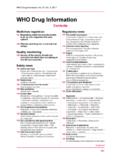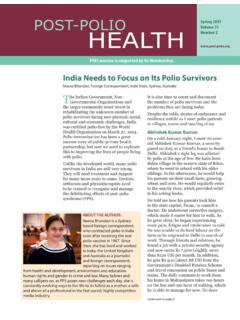Transcription of Guidance on how to prioritize globally constrained …
1 1 Guidance on how to prioritize globally constrained BCG vaccine supply to countries produced by WHO Dept. of Immunizations, Vaccines and Biologicals, the WHO Global Tuberculosis Programme and UNICEF supply and Programme Divisions 22 July 2015 Context Over the past three years, there has been a decline in global availability of BCG vaccine . At the same time, demand from 70 countries traditionally procuring through one procurement agency, UNICEF supply Division, has increased, in part as countries that have traditionally self-procured BCG vaccine have also turned to UNICEF. As a result, in 2015, 180 million doses are required to meet UNICEF SD demands, and only 107 million doses have been made available from manufacturers. In order to manage the supply -demand gap, UNICEF is shipping BCG vaccines more frequently and in smaller amounts to alleviate the shortfall and avoid stock-outs while exhausting country buffer stocks.
2 Several actions to mitigate the shortfall have been taken and are ongoing: 1. Communication: a. UNICEF SD has provided information on the supply situation on its website, and specifically notified its country offices, regional offices and the UNICEF Programme Division on the supply constraint. Consultations with programme partners such as WHO and the PAHO Revolving Fund (RF), and Bill and Melinda Gates Foundation (BMGF) were initiated and continues. 2. Securing additional supplies: a. Through existing manufacturers of WHO-pre-qualified BCG vaccine , an additional 7 million doses have been sourced for 2015. b. New potential suppliers of BCG vaccine have been encouraged to seek pre-qualification rapidly and the vaccine has been prioritized in the pre-qualification process. One additional manufacturer is expected to have its BCG vaccine WHO prequalified in 2015.
3 C. Consultations with manufacturers of non-prequalified BCG vaccine with local production capacity are being initiated to encourage the support of national vaccine requirements in the producing country as well as assess capacity to meet requirements from the international market. This would allow self-procuring countries which do not require vaccines to be prequalified to access the supply , which would reduce the supply gap through UNICEF for prequalified vaccines. d. The other UN procurement agency (PAHO RF) has been approached to source any extra availability under their contracts, but none is available. e. UNICEF Senior Management continues advocacy for additional supply with the vaccine industry. 3. Managing shortfalls and postponing supply to 2016: a. Available BCG vaccine will be allocated on a priority basis to countries at risk of stock out.
4 B. Partial shipments are being made to some countries in order to maximize the global buffer with suppliers rather than stocking up at country levels. 4. Programme considerations: a. Countries should be encouraged (where possible), to reduce wastage rates and review wastage rate used in calculation of requirement b. prioritize countries with higher incidence of tuberculosis over countries with lower incidence c. Discourage use of booster or repeat doses of BCG. This note is focused on providing Guidance on the last two action points. It should be noted that this may not solve the supply gap for UNICEF SD as even based on these prioritization criteria, supply will be insufficient to meet requirements in countries highlighted in yellow in the attached list. 2 WHO recommendations on BCG Use of BCG vaccine in high burden vs.
5 Low burden countries In settings where tuberculosis (TB) is highly endemic or where there is high risk of exposure to TB, a single dose of BCG vaccine should be given to all infants1. Neonatal BCG vaccination provides substantial protection against the more severe types of disseminated TB, such as miliary TB and tuberculosis meningitis, to which infants and young children are particularly susceptible2. Neonates should receive one dose of BCG as soon as possible after birth. An infant that had not received the BCG dose soon after birth can be given a dose until 12 months of age, after that no dose should be given3. In terms of the use of BCG in low-burden countries, the WHO Position Paper on BCG vaccine states4: Low-burden countries may choose to limit BCG vaccination to neonates and infants of recognized high-risk groups for TB or to tuberculin-negative older children.
6 In some countries with low TB prevalence, BCG vaccination is largely replaced by intensified case detection and supervised early treatment. Since an increasing number of industrialized countries are likely to reconsider their BCG vaccination policy during the coming years, the International Union Against Tuberculosis and Lung Disease has developed criteria defining low endemicity that may be helpful in this decision process. To change from general to selective BCG vaccination, an efficient notification system must be in place in addition to the following criteria: an average annual notification rate of smear-positive pulmonary TB cases below 5 per 100 000; or an average annual notification rate of tuberculous meningitis in children aged under five years below 1 per 10 million population during the previous five years; or an average annual risk of tuberculous infection below BCG in adolescents and adults There is no evidence that revaccination with BCG affords any additional protection, and general revaccination is therefore not recommended5.
7 However, given the serious consequences of developing multidrug-resistant disease and the low reactogenicity of the vaccine , BCG vaccination may be considered for all HIV-negative, unvaccinated, tuberculin-negative persons who are in an unavoidable close exposure to multidrug-resistant tuberculosis (MTB) ( health care workers in facilities still lacking of proper TB infection control measures in place). BCG in HIV-infected newborns In children who are known to be HIV-infected, BCG vaccine should not be given1. In infants whose HIV status is unknown and who are born to HIV-positive mothers and who lack symptoms suggestive of HIV, BCG vaccine should be given after considering local factors1. Such factors are likely to be important determinants of the risk-benefit balance of such an approach and include: coverage and success of the prevention of mother to child transmission of HIV (PMTCT) programme; possibility of deferring BCG vaccination in HIV-exposed infants until HIV infection status has been established; availability of early diagnosis of HIV infection in infants; and, provision of early ART to HIV-positive infants.
8 1 Revised BCG vaccination guidelines for infants at risk for HIV infection. Weekly Epidemiological Record, 2007, 82:193-196. 2 Trunz BB et al. Effect of BCG vaccination on childhood tuberculosis meningitis and miliary tuberculosis worldwide: a meta-analysis and assessment of cost-effectiveness. Lancet, 2006, 367:1173-1180. 3 Table 3: Recommendations* for Interrupted or Delayed Routine Immunization - Summary of WHO Position Papers. 4 WHO Position Paper on BCG, Weekly Epidemiological Record, 23 Jan. 2004, 79: 27ff 5 Global Tuberculosis Programme and Global Programme on Vaccines. Statement on BCG revaccination for the prevention of tuberculosis. Weekly Epidemiological Record, 1995, 32:229-231. 3 Guidance on the management of BCG vaccine supply shortage In light of the shortage of BCG vaccines, WHO has prepared a prioritized list of countries with the highest TB rate per 100,000 population; hence highest TB transmission.
9 Annex 1 lists these countries in yellow by WHO region. These are the countries where infants have the highest risk of being infected with TB in the household. 1. vaccine manufacturers are called to rapidly increase the supply of BCG vaccine to the global market. UNICEF SD and other procurement agencies should use their purchasing power and advocacy role to further engage with vaccine manufacturers to increase supply . 2. Through careful planning and considered shipments, procurement agencies such as UNICEF supply Division should provide vaccines to priority countries that request the supply of BCG vaccine . It is acknowledged that even based on this prioritisation, stock outs are likely to occur. 3. In countries where vaccination policy calls for high-risk sub-gr oups to receive BCG vaccination, a limited supply of vaccine should be made available to cover this need.
10 4. Countries are called to reduce BCG vaccine wastage as best possible without decreasing vaccination coverage. 5. If BCG vaccine supply remains inadequate to meet the countries needs, vaccination programmes in the countries with highest TB rates (marked in yellow in Annex A) should receive priority and be fully supplied with BCG vaccines. In particular, countries with health systems that are not able to track and provide preventive treatment to children should receive priority. Next steps - WHO6 will gather further information on the exact reasons of an increased demand for BCG vaccines. - The WHO7 vaccines pre-qualification team (PQT) will gather information on manufacturing capacity of existing and pipeline BCG manufacturers of WHO Prequalified BCG vaccine - WHO will also issue statements to its network of country offices to advise that countries are applying WHO s existing recommendations on the use of BCG (no need for revaccination) and that prenatal care facilities are trained to counsel pregnant women for symptoms of TB (including household family members).


















